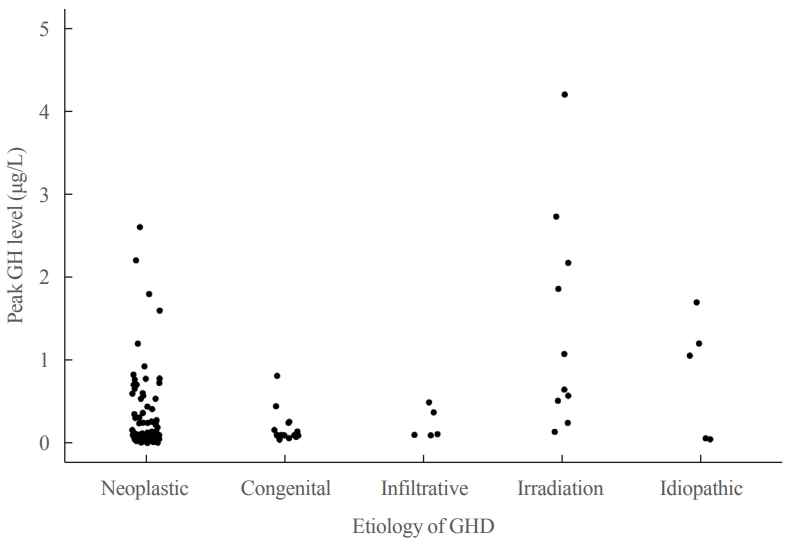- Hypothalamus and Pituitary Gland
- Metabolic Impacts of Discontinuation and Resumption of Recombinant Human Growth Hormone Treatment during the Transition Period in Patients with Childhood-Onset Growth Hormone Deficiency
-
Yun Jeong Lee, Yunha Choi, Han-Wook Yoo, Young Ah Lee, Choong Ho Shin, Han Saem Choi, Ho-Seong Kim, Jae Hyun Kim, Jung Eun Moon, Cheol Woo Ko, Moon Bae Ahn, Byung-Kyu Suh, Jin-Ho Choi
-
Endocrinol Metab. 2022;37(2):359-368. Published online April 25, 2022
-
DOI: https://doi.org/10.3803/EnM.2021.1384
-
-
4,471
View
-
185
Download
-
3
Web of Science
-
4
Crossref
-
 Abstract Abstract
 PDF PDF Supplementary Material Supplementary Material PubReader PubReader  ePub ePub
- Background
Discontinuing growth hormone (GH) treatment during the transition to adulthood has been associated with adverse health outcomes in patients with childhood-onset growth hormone deficiency (CO-GHD). This study investigated the metabolic changes associated with interrupting GH treatment in adolescents with CO-GHD during the transition period.
Methods
This study included 187 patients with CO-GHD who were confirmed to have adult GHD and were treated at six academic centers in Korea. Data on clinical parameters, including anthropometric measurements, metabolic profiles, and bone mineral density (BMD) at the end of childhood GH treatment, were collected at the time of re-evaluation for GHD and 1 year after treatment resumption.
Results
Most patients (n=182, 97.3%) had organic GHD. The median age at treatment discontinuation and re-evaluation was 15.6 and 18.7 years, respectively. The median duration of treatment interruption was 2.8 years. During treatment discontinuation, body mass index Z-scores and total cholesterol, low-density lipoprotein, and non-high-density lipoprotein (HDL) cholesterol levels increased, whereas fasting glucose levels decreased. One year after GH treatment resumption, fasting glucose levels, HDL cholesterol levels, and femoral neck BMD increased significantly. Longer GH interruption (>2 years, 60.4%) resulted in worse lipid profiles at re-evaluation. The duration of interruption was positively correlated with fasting glucose and non-HDL cholesterol levels after adjusting for covariates.
Conclusion
GH treatment interruption during the transition period resulted in worse metabolic parameters, and a longer interruption period was correlated with poorer outcomes. GH treatment should be resumed early in patients with CO-GHD during the transition period.
-
Citations
Citations to this article as recorded by  - Ghrelin regulating liver activity and its potential effects on liver fibrosis and Echinococcosis
Jiang Zhu, Tanfang Zhou, Meng Menggen, Kalibixiati Aimulajiang, Hao Wen
Frontiers in Cellular and Infection Microbiology.2024;[Epub] CrossRef - Composición de la microbiota en pacientes con déficit de hormona de crecimiento antes y después de recibir tratamiento
Patricia García Navas, María Yolanda Ruíz del Prado, Pablo Villoslada Blanco, Emma Recio Fernández, María Ruíz del Campo, Patricia Pérez Matute
Anales de Pediatría.2024;[Epub] CrossRef - Relationship between the Stimulated Peak Growth Hormone Level and Metabolic Parameters in Children with Growth Hormone Deficiency
Seong Yong Lee
The Ewha Medical Journal.2023;[Epub] CrossRef - Dyslipidaemia and growth hormone deficiency – A comprehensive review
Matthias Hepprich, Fahim Ebrahimi, Emanuel Christ
Best Practice & Research Clinical Endocrinology & Metabolism.2023; 37(6): 101821. CrossRef
- A Study on the Relationship Between Genotype and Phenotype in Korean Patients with Congenital Adrenogenital Syndrome Caused by 21-hydroxylase Deficiency.
-
Dong Kyu Jin, Jung Sim Kim, Seung Mi Song, Sung Joon Park, He Zin Hwang, Hwa Young On, Phil Soo Oh, Si Whan Koh, Mee Ryung Uhm, Dong Hwan Lee, Jah Hoon Shin, Heon Seok Han, Hong Sik Kim, Cheol Woo Ko, Han Wook Yoo, Jin Sung Lee, Duk Hee Kim
-
J Korean Endocr Soc. 2000;15(2):237-247. Published online January 1, 2001
-
-
-
 Abstract Abstract
 PDF PDF
- BACKGROUND
Congenital adrenal hyperplasia (CAH) results from an inherited defect in enzymatic steps required to synthesize cortisol from cholesterol. 21-hydroxylase deficiency accounts for 95% cases of CAH. It appears that the frequency and the type of the responsible mutations differ according to the ethnic background and the type of mutation can predict the clinical outcomes such as salt losing type (SL), simple virilizing type (SV) and non-classic type (NC). METHODS: We have analyzed CYP21 genes in 55 Korean cases (110 chromosomes) of CAH by Southern blotting, PCR-dot hybridization and PCR amplification-created restriction site method. The patients include 43 cases of SL and 12 of SV. None of the NC was found. RESULTS: We found the mutations in 94% (103/110) of the examined chromosomes. A total of 10 types of mutations were discovered. The mutations include aberrant splicing of intron 2 (i2, 35%), CYP21 gene deletion (32%) and I172N (11%) in order. When the relationship between the clinical types and genotypes were correlated, most of the SL patients have either i2 (42%) or CYP21 gene deletion (41%), while SV patients have I172N (33%) or P30L (21%). The parents' mutation was investigated in 20 cases. In 4 families, one of the parents was not the obligatory heterozygote carrier i.e. did not have a mutation. The results suggest the high incidence of de novo mutation. CONCLUSION: We have identified the frequency of mutations of the CYP21 in Korean AGS patients. Our results shows that the clinical type of AGS can be predicted from the genotypes of CYP21. Also the high incidence of de novo mutation of CYP21 confirmed the genetic instability of major histocompatibility III region where the CYP21 is located.
|





